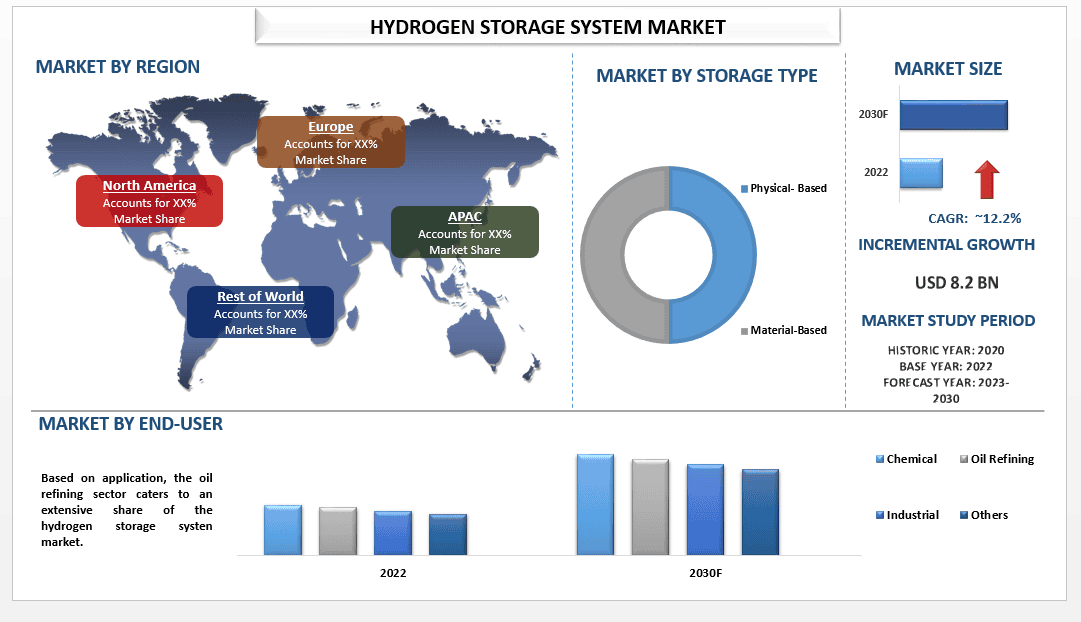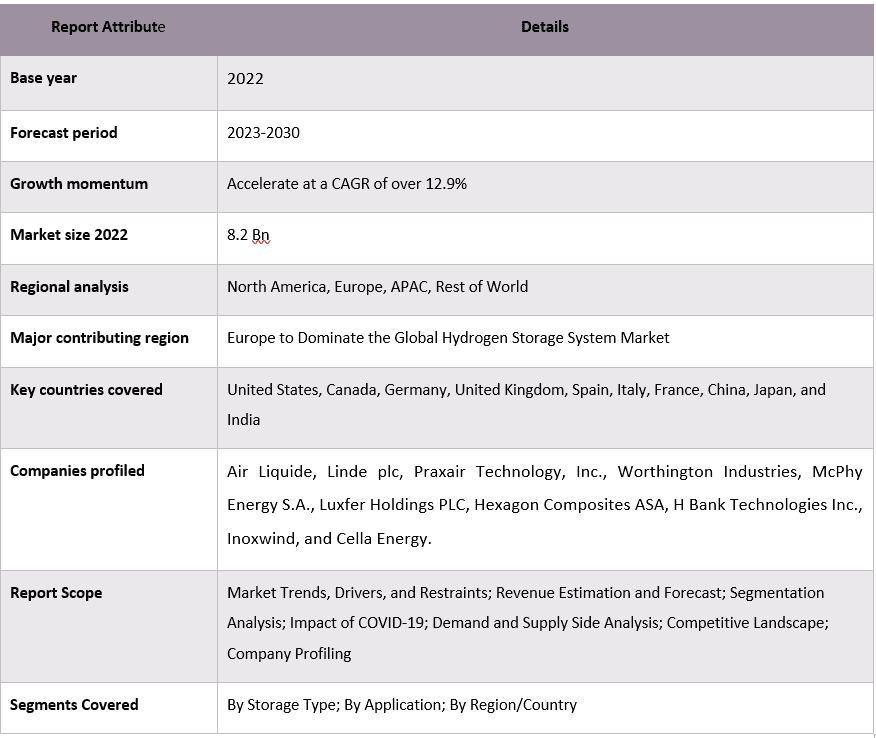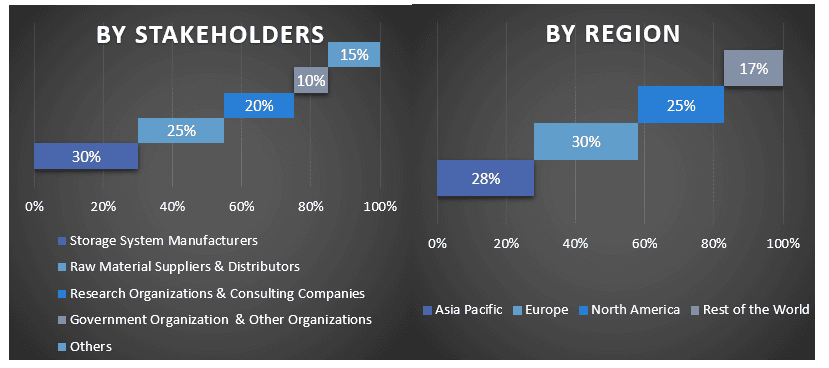- Home
- Chi siamo
- Settore
- Servizi
- Lettura
- Contattaci
Mercato dei sistemi di stoccaggio dell'idrogeno: analisi attuale e previsioni (2023-2030)
Enfasi sul Tipo di Stoccaggio (Fisico, Basato su Materiali); Applicazione (Chimica, Raffinazione del Petrolio, Industriale e Altre); e Regione/Paese

Si prevede che il mercato globale dei sistemi di stoccaggio dell'idrogeno crescerà a un tasso significativo di circa il 12,2% durante il periodo di previsione. La domanda di sistemi di stoccaggio dell'idrogeno è in aumento in tutto il mondo a causa di diversi fattori, come la crescente necessità di fonti di energia pulita e rinnovabile, poiché governi e aziende mirano a ridurre le emissioni di gas serra e a raggiungere i propri obiettivi climatici. I sistemi di stoccaggio dell'idrogeno svolgono un ruolo cruciale nell'economia dell'idrogeno, che mira a produrre, immagazzinare e distribuire l'idrogeno come combustibile pulito e sostenibile. Inoltre, il crescente utilizzo di veicoli a celle a combustibile a idrogeno è un altro fattore che guida la domanda di sistemi di stoccaggio dell'idrogeno. Questi veicoli richiedono sistemi di stoccaggio dell'idrogeno efficienti e sicuri per immagazzinare il carburante necessario per il trasporto. Con l'introduzione di un numero sempre maggiore di veicoli a celle a combustibile a idrogeno, si prevede che la domanda di sistemi di stoccaggio dell'idrogeno aumenterà. Inoltre, i progressi nelle tecnologie di stoccaggio dell'idrogeno, compreso lo sviluppo di nuovi materiali e tecnologie che offrono prestazioni migliori e costi inferiori, stanno contribuendo all'aumento della domanda di questi sistemi. Ad esempio, Plug Power ha annunciato lo sviluppo di C3V, un nuovo materiale di stoccaggio dell'idrogeno con un'elevata capacità e una cinetica rapida, nel 2023.
Air Liquide, Linde plc, Praxair Technology, Inc., Worthington Industries, McPhy Energy S.A., Luxfer Holdings PLC, Hexagon Composites ASA, H Bank Technologies Inc., Inoxwind e Cella Energy sono alcuni dei principali attori del mercato. Questi operatori hanno intrapreso diverse operazioni di fusione e acquisizione, oltre a partnership, per fornire ai clienti prodotti/tecnologie hi-tech e innovativi.
Approfondimenti presentati nel rapporto
“Tra i tipi di stoccaggio, la categoria basata sulla fisica registrerà un CAGR più elevato durante il periodo di previsione.”
In base al tipo di stoccaggio, il mercato è suddiviso in basato sulla fisica e basato sui materiali. Tra questi, i metodi basati sui materiali hanno il potenziale per essere più economici ed efficienti dal punto di vista energetico rispetto ai metodi basati sulla fisica a lungo termine, in quanto possono immagazzinare più idrogeno per unità di volume e peso. Tuttavia, richiedono ulteriore ricerca e sviluppo per superare sfide come la stabilità, la durata e la scalabilità.
“Tra le applicazioni, il segmento della raffinazione del petrolio deterrà una quota significativa del mercato nel 2020.”
Il mercato dei sistemi di stoccaggio dell'idrogeno è suddiviso in quattro segmenti: chimico, raffinazione del petrolio, industriale e altri, in base alla loro applicazione. Il segmento della raffinazione del petrolio detiene una quota importante in questo mercato per diversi motivi. In primo luogo, l'idrogeno è una fonte di energia sostenibile e pulita che aiuta a ridurre l'impronta di carbonio delle raffinerie di petrolio. In secondo luogo, le norme e i regolamenti governativi volti a ridurre le emissioni di gas serra stanno incrementando la domanda di sistemi di stoccaggio dell'idrogeno nelle raffinerie di petrolio. I governi di tutto il mondo stanno promuovendo l'uso di fonti di energia rinnovabile e incoraggiando lo sviluppo di tecnologie a idrogeno per combattere il cambiamento climatico.
Copertura del rapporto sul mercato dei sistemi di stoccaggio dell'idrogeno

“L'Europa deterrà una quota significativa del mercato.”
L'Europa ha visto una crescita considerevole nel mercato dei sistemi di stoccaggio dell'idrogeno. Poiché la Commissione Europea ha proposto di produrre 10 milioni di tonnellate di idrogeno rinnovabile entro il 2030 e di importarne 10 milioni di tonnellate entro il 2030, questo è il fattore principale che guida la domanda di mercato per i sistemi di stoccaggio dell'idrogeno.
Inoltre, il crescente sviluppo di strutture di ricerca e sviluppo sull'idrogeno che dimostrano una catena del valore completa dalla produzione e stoccaggio al trasporto e all'uso finale sta accelerando le dimensioni del mercato dei sistemi di stoccaggio dell'idrogeno
Ad esempio: l'European Marine Energy Centre (EMEC) gestisce una struttura di ricerca e sviluppo sull'idrogeno in cui sta testando e dimostrando sistemi di produzione e stoccaggio di idrogeno verde, oltre a consentire lo sviluppo di soluzioni logistiche per trasportare l'idrogeno ad altre isole dell'arcipelago e alla terraferma del Regno Unito per l'uso in applicazioni finali nei settori dell'energia, del calore e dei trasporti.
Motivi per acquistare questo rapporto:
- Lo studio include l'analisi delle dimensioni del mercato e delle previsioni, convalidate da esperti chiave del settore autenticati.
- Il rapporto presenta una rapida panoramica delle prestazioni complessive del settore a colpo d'occhio.
- Il rapporto copre un'analisi approfondita dei principali concorrenti del settore con un focus primario sulle principali informazioni finanziarie aziendali, sul portafoglio prodotti, sulle strategie di espansione e sugli sviluppi recenti.
- Esame dettagliato dei fattori trainanti, dei vincoli, delle tendenze chiave e delle opportunità prevalenti nel settore.
- Lo studio copre in modo completo il mercato attraverso diversi segmenti.
- Analisi approfondita a livello regionale del settore.
Opzioni di personalizzazione:
Il mercato globale dei sistemi di stoccaggio dell'idrogeno può essere ulteriormente personalizzato in base alle esigenze o a qualsiasi altro segmento di mercato. Oltre a questo, UMI comprende che potresti avere le tue esigenze aziendali, quindi sentiti libero di contattarci per ottenere un rapporto che si adatti completamente alle tue esigenze.
Indice
Metodologia di ricerca per l'analisi del mercato dei sistemi di stoccaggio dell'idrogeno (2023-2030)
L'analisi del mercato storico, la stima del mercato attuale e la previsione del mercato futuro del mercato globale dei sistemi di stoccaggio dell'idrogeno sono stati i tre passaggi principali intrapresi per creare e analizzare l'adozione dei sistemi di stoccaggio dell'idrogeno nelle principali regioni a livello globale. È stata condotta un'esauriente ricerca secondaria per raccogliere i dati storici del mercato e stimare le dimensioni attuali del mercato. In secondo luogo, per convalidare queste intuizioni, sono stati presi in considerazione numerosi risultati e ipotesi. Inoltre, sono state condotte anche interviste primarie esaustive con esperti del settore lungo tutta la catena del valore del mercato globale dei sistemi di stoccaggio dell'idrogeno. Post-ipotesi e convalida dei dati di mercato attraverso interviste primarie, abbiamo impiegato un approccio top-down/bottom-up per prevedere le dimensioni complete del mercato. Successivamente, sono stati adottati metodi di suddivisione del mercato e di triangolazione dei dati per stimare e analizzare le dimensioni del mercato dei segmenti e sottosegmenti del settore di pertinenza. La metodologia dettagliata è spiegata di seguito:
Analisi delle dimensioni del mercato storico
Passaggio 1: Studio approfondito delle fonti secondarie:
È stato condotto uno studio secondario dettagliato per ottenere le dimensioni storiche del mercato dei sistemi di stoccaggio dell'idrogeno attraverso fonti interne aziendali come relazioni annuali e bilanci, presentazioni sulle prestazioni, comunicati stampa, ecc., e fonti esterne tra cui riviste, notizie e articoli, pubblicazioni governative, pubblicazioni della concorrenza, relazioni di settore, database di terze parti e altre pubblicazioni credibili.
Passaggio 2: Segmentazione del mercato:
Dopo aver ottenuto le dimensioni storiche del mercato dei sistemi di stoccaggio dell'idrogeno, abbiamo condotto un'analisi secondaria dettagliata per raccogliere informazioni storiche sul mercato e quote per diversi segmenti e sottosegmenti per le principali regioni. I segmenti principali inclusi nel rapporto sono il tipo di stoccaggio e l'applicazione. Sono state condotte ulteriori analisi a livello di paese per valutare l'adozione complessiva dei modelli di test in quella regione.
Passaggio 3: Analisi dei fattori:
Dopo aver acquisito le dimensioni storiche del mercato di diversi segmenti e sottosegmenti, abbiamo condotto un'analisi dei fattori dettagliata per stimare le dimensioni attuali del mercato dei sistemi di stoccaggio dell'idrogeno. Inoltre, abbiamo condotto un'analisi dei fattori utilizzando variabili dipendenti e indipendenti come il tipo di stoccaggio e l'applicazione dei sistemi di stoccaggio dell'idrogeno. È stata condotta un'analisi approfondita degli scenari di domanda e offerta considerando le principali partnership, fusioni e acquisizioni, l'espansione aziendale e i lanci di prodotti nel settore del mercato dei sistemi di stoccaggio dell'idrogeno in tutto il mondo.
Stima e previsione delle dimensioni attuali del mercato
Dimensionamento attuale del mercato: sulla base di informazioni utili dai 3 passaggi precedenti, siamo giunti alle dimensioni attuali del mercato, ai principali attori nel mercato globale dei sistemi di stoccaggio dell'idrogeno e alle quote di mercato dei segmenti. Tutte le quote percentuali richieste e le suddivisioni del mercato sono state determinate utilizzando l'approccio secondario sopra menzionato e sono state verificate attraverso interviste primarie.
Stima e previsione: per la stima e la previsione del mercato, sono stati assegnati pesi a diversi fattori, tra cui driver e tendenze, vincoli e opportunità disponibili per le parti interessate. Dopo aver analizzato questi fattori, sono state applicate tecniche di previsione pertinenti, ovvero l'approccio top-down/bottom-up, per arrivare alla previsione di mercato per il 2028 per diversi segmenti e sottosegmenti nei principali mercati a livello globale. La metodologia di ricerca adottata per stimare le dimensioni del mercato comprende:
- Le dimensioni del mercato del settore, in termini di fatturato (USD) e il tasso di adozione del mercato dei sistemi di stoccaggio dell'idrogeno nei principali mercati a livello nazionale
- Tutte le quote percentuali, le suddivisioni e le ripartizioni dei segmenti e sottosegmenti di mercato
- Attori chiave nel mercato globale dei sistemi di stoccaggio dell'idrogeno in termini di prodotti offerti. Inoltre, le strategie di crescita adottate da questi attori per competere nel mercato in rapida crescita.
Convalida delle dimensioni e della quota di mercato
Ricerca primaria: sono state condotte interviste approfondite con i Key Opinion Leaders (KOL) tra cui Top Level Executives (CXO/VP, Sales Head, Marketing Head, Operational Head, Regional Head, Country Head, ecc.) nelle principali regioni. I risultati della ricerca primaria sono stati quindi riassunti ed è stata eseguita un'analisi statistica per dimostrare l'ipotesi affermata. Gli input della ricerca primaria sono stati consolidati con i risultati secondari, trasformando quindi le informazioni in intuizioni utili.
Suddivisione dei partecipanti primari nelle diverse regioni

Ingegneria del mercato
È stata impiegata la tecnica di triangolazione dei dati per completare la stima complessiva del mercato e per arrivare a numeri statistici precisi per ciascun segmento e sottosegmento del mercato globale dei sistemi di stoccaggio dell'idrogeno. I dati sono stati suddivisi in diversi segmenti e sottosegmenti dopo aver studiato vari parametri e tendenze nelle aree del tipo di stoccaggio e dell'applicazione nel mercato globale dei sistemi di stoccaggio dell'idrogeno.
L'obiettivo principale dello studio sul mercato globale dei sistemi di stoccaggio dell'idrogeno
Le tendenze di mercato attuali e future del mercato globale dei sistemi di stoccaggio dell'idrogeno sono state individuate nello studio. Gli investitori possono ottenere approfondimenti strategici per basare la loro discrezione per gli investimenti sull'analisi qualitativa e quantitativa eseguita nello studio. Le tendenze di mercato attuali e future hanno determinato l'attrattiva complessiva del mercato a livello regionale, fornendo una piattaforma per il partecipante industriale per sfruttare il mercato non sfruttato per beneficiare di un vantaggio di pioniere. Altri obiettivi quantitativi degli studi includono:
- Analizzare le dimensioni del mercato attuali e previste del mercato dei sistemi di stoccaggio dell'idrogeno in termini di valore (USD). Inoltre, analizzare le dimensioni del mercato attuali e previste di diversi segmenti e sottosegmenti.
- I segmenti nello studio includono aree di tipo di stoccaggio e applicazione.
- Definire e analizzare il quadro normativo per il sistema di stoccaggio dell'idrogeno
- Analizzare la catena del valore coinvolta con la presenza di vari intermediari, insieme all'analisi dei comportamenti dei clienti e della concorrenza del settore.
- Analizzare le dimensioni del mercato attuali e previste del mercato dei sistemi di stoccaggio dell'idrogeno per la regione principale.
- I principali paesi delle regioni studiati nel rapporto includono Asia Pacifico, Europa, Nord America e il resto del mondo.
- Profili aziendali del mercato dei sistemi di stoccaggio dell'idrogeno e le strategie di crescita adottate dagli operatori di mercato per sostenersi nel mercato in rapida crescita.
- Analisi approfondita a livello regionale del settore
Correlati Report
I clienti che hanno acquistato questo articolo hanno acquistato anche










